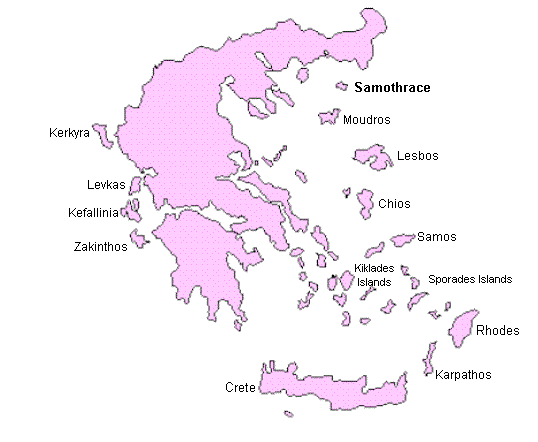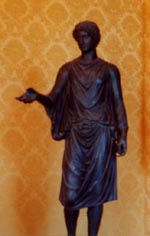| 5 | The Camillo Story |
The Name Camillo
The island of Samothrace is an outer island, in
the north- eastern sea of Greece, close to the Turkish Gallipoli
peninsular and has been traditionally considered to be “a sanctuary of
the Gods”.

Here King Philip of Macedonia met and fell in love with his wife Olympias
of Epirus, who was to be the mother of Alexander the Great. The legend
that Dardanos, the legendary founder of Troy, had come from Samothrace and
that his descendant, Aeneas, had brought the cult to Rome, gave Samothrace
a particular interest to the Romans. In fact even the Roman Emperor,
Hadrian, visited Samothrace.
Greek mythology tells that the mistress of
Samothrace is Elektra, the
daughter of Atlas; after mating with Zeus she gave birth to Dardanos, Aetion, and Harmonia.
The latter celebrated on the island her wedding to Kadmos.
This Kadmos, Cadmus, or Cadmilus,
was the Son of Agenor, king of Phoenicia, and brother of Europa, husband
of Harmonia, and father of Semele. He was the legendary founder of Thebes
and the one who slew the dragon, planted its teeth, and built the city
with the help of some of the soldiers that sprang from the teeth. He and
his wife were finally turned into serpents by the gods.
Cadmilus is said to have introduced into Greece an alphabet, possibly
based upon 16 characters derived from Phoenicia, as the Phoenecians were
the first inventors of the alphabet as we know it.
He belongs to the class of heroes, who succeeded the reigns of the
gods and demigods on earth and who were parents and instructors of mortals.
His name is surely at the origin of the name Camillo.
A very strong confirmation of the "Camillo" origin in Samothraki is the very common surname "Kamil" in the nearby Istanbul and generally throughout Turkey.
Today in Italy, the name "Camillo" is generally
a first name, while surnamed Camillos are not at all common and those few,
are mainly from the Veneto region. There is also a sizeable branch in the
Lazio region (Rome), which most likely is related, in the distant past to
Camillos of the Veneto branch.
The most ancient Roman reference to "camillo" stems from the Latin ritual of designating young Roman boys to assist the high priests during sacrifices. The religious connection with the Greek mythological character Cadmilus, is significant. These camillos were required to be of pre-pubescent age, of free birth, that is, not of slaves, and with both parents still alive. They dressed in short tunics, with long sleeves and carried the sacred vessels containing incense. A bronze statue of a camillus can be seen in the Palazzo dei Conservatori at the Capitoline Museum in Rome.
 The bronze statue of a "camillus" in the
Capitoline museum of Rome
The bronze statue of a "camillus" in the
Capitoline museum of Rome
It was certainly one of these boys, who slowly became
known to everybody, by the name of his profession, just like the Smiths,
the Bakers, etc. So that it was this first Mr. Camillo who founded a
dynasty of Camillos that thrives even today.
The first recorded Camillo family was that of Marco
Furio Camillo and son, Lucio Furio, Roman dictators dating from 403
B.C.
Several
times Consul, Marco Furio Camillo distinguished himself as a conqueror,
greatly expanding Roman territory, with the conquest of Veio. Rome was
later conquered by the Gauls during his exile and when he returned, he
annulled the surrender treaty with the famous words: "The homeland is
saved with iron, not with gold." and hence expelled the Gauls by
force. He was subsequently to be known as the Second Founder of Rome.
Today in Rome there is a subway station named Furio Camillo in his honour.
His son, Lucio Furio, was a no lesser figure in Roman history than his
father was.
There is no direct evidence however, that there is any
hereditary link with the present day Camillos. However, the fact that
branches of Camillos have existed in the Lazio region and in the Abruzzo
region, close to Rome, does suggest that the origin of the family may have
in fact come from ancient Rome itself.
There has been a very important branch of the Camillo family in the Ligurian region: “this illustrious and noble family that from the XII century, had played a primary role in the political life of the Ligurian Republic”.
A colourful character worth mentioning was Franceschino
da Camilla, who built up a considerable wealth trading with
Constantinople. It is noted that in 1246 he rented two ships to King Louis
IX of France for use in the crusades. He acquired fame by managing to sign
a treaty in 1267 with the sultan of Constantinople, obtaining important
privileges for Genoa.
On the 2nd of July 1270 a private expedition of 10,000
crusaders left Genova, via Cagliary in Sardinia, to do “Christian
justice” in Northern Africa. They arrived in Tunisia and besieged the
city of Carthage. The governors back home in Genoa, worried that these
belligerent acts would damage their commercial relations with the Arab
princedoms, nominated Franceschino da Camilla leader of all the Genoans in
Africa, entrusting him “to govern them with justice”, that is, to
tactfully make peace, saving face for the crusaders and reopen business
relations with the Arabs. He set sail for Tunisia and arrived on the 7th
of September and quickly reassured the sultan of Genoa’s peaceful
intentions, ratifying the previous treaty.
All military operations were concluded by the 30th
October and the deal was actually signed and sealed “on the 18th of
November, on the beach of Tunisia, in the locality of Carthage, under the
tent of the King...”, as wrote the notary brought over for the occasion.
The sultan had to pay an indemnity and grant favourable conditions for the
reopening of Tunisia to Genoan merchants. In return Genoa promised not to
partake any more in armed raids of Tunisia.
On the return trip Camilla’s fleet made a call at
Trapani, where it was caught by a violent storm, whereby 18 ships sank,
with 4,000 victims.
In 1282 Camilla was nominated commander of a small contingent of troops, 200 horsemen, 300 lancers and 200 archers, to pacify southern Corsica. A feudal land-lord, Sinucello della Rocca, had rebelled and ran amok with his men, robbing and ravishing the countryside. Camilla set foot in Bonifacio, the southernmost port in front of Sardinia, and rode north, routing the rebels, while his ships followed him along the coast. After numerous skirmishes, he managed to re-conquer the various fortifications held by the rebels, while Sinucello fled to the mainland.
Eighty years later, Gentile
Camilla, a distant relation of our previous hero, continued the family
tradition of community leadership. Gentile was essentially a wise
administrator and a very equilibrated person, “the typical example of
the solid aristocracy that supported the Republic and ensured its
continuation”.
In 1466 he was nominated consul of the Genoan colony Kafa
(now Feodosija) on the Black Sea and had to travel overland for four
months to get there, as the Turkish pirates made travel by sea very
dangerous. He successfully governed there for two years, overcoming many
difficulties. Afterwards he had several posts as commissioner, in Corsica,
Massa and lastly in Lerici in 1484, to follow the war with Florence in
Sarzana. In 1492 he was back in Corsica as governor.
There was also a Tuscan group of Camillos, some of whom
emerged enough to be remembered in Italian history. There was a famous
sculptor, born in Florence in 1530, Francesco Camilliani, also known as
della Camilla, who was related to the Gucci family. His most renowned
piece of sculpture was a monumental fountain, that ended up in Palermo,
Sicily, in piazza Pretoria. His son Camillo Camilliani, became an
important architect, who took up residence in Sicily in 1574, having been
put in charge of the Royal restoration office. He followed many important
commissions all over Sicily, including the renewal of the very fountain
sculptured by his father and many castles, fortresses, towers, churches
etc.
An ancient presence of Camillos has been found in Spain, at the church Nuestra Senora de la Antica in Dalladalio, where the christening of Juan Camillo Angeli, son of Giovanni Camillo and Maddalena degli Angeli was registered on the 9th March 1579. Furthermore, the christening of Catalina Campo Camillo, daughter of Giovanni Campo and Catalina Camillo, was registered at San Michele, on 21st May 1671.
A certain Camillo
Camilli, born either in Siena or Monte San Savino, became famous in
his own time for his poems and operas, which were published in Venice from
1583 to 1607. In his later life, he lived in Ragusa in Sicily, where he
died in 1615.
The Abruzzo branch has a recorded history going back to
the 13th century, when the family there was called "Camilli",
which is the plural of "Camillo" and is an understandable change.
The family had some illustrious forebears, learned in the law, who were
ambassadors to the court of Naples. At the beginning of the 15th century,
the family from Aquila acquired a noble title, but from the second half of
the century, further traces are lost.
It is only in 1753 that we pick up the traces again, with
the birth in Beffi di Acciano, near L’Acquila, of Francesco Saverio Camilli, “of a borghese, land-owning family,
relatively well-off”. He received a classical education, typical of
intellectual families of the time and became dean of Greek and Latin at
the Royal College of Aquila. He travelled frequently to the capital, which
was then Naples, under French dominion and became politically involved in
resolving the basic economic problems deriving from a monstrously rich
Borbone capital, compared to the extremely poor country provinces. He
battled tenaciously for the construction of roads in the country and
complained of all the money wasted by the French governors on useless
luxuries in the capital. His writings were forerunners to the future
political policies of government spending in the poor south, the so-called
“mezzogiorno”.
A certain Marcello
Staglieno Camilla, distinguished himself as Bishop of the city of
Turin from 1300 to 1319.
In the Dizionario Storico Blasonico of noble Italian
families, there is mention of a Camilla family, originating in the Lazio
area and at times having lived in Rome itself. The author, G.B.Crollalanza,
carefully describes the coat-of-arms, with the crown formed of eight large
pearls, only five being visible, mounted on a golden circle. This presence
in Rome further strengthens the evidence of a direct Ancient Roman origin
of all present day Camillos.
Today in the city of Rome, there are 70 Camillo families
and also a large number of families with variables of the name Camillo,
such as Camilli, Camilletti, Camillini, Camilloni, Camilleri, Camillucci
etc. These names most certainly derived from the original Camillo and
represent in fact common variations:
in Italy the endings “..etti”, “..ini” are usually
diminutives, indicating “small Camillos”; the endings “..oni”,
“..otti”: “big Camillos”; “..ucci”: “cute Camillos”; “..acci”:
“nasty Camillos” etc.
Counting all of the names, plus those with different
still variations, with two “ms” or with only one “l”, the total
number of Camillo families in Rome rises to fully 667. Such a large
concentration of Camillos in Rome, does tend to suggest that the family
may in fact have originated in ancient Rome, as we have contemplated above.
Click here for map of distribution of Camillo's in Italy
The
Camillos have migrated far and wide: there are 57 in France, 7 in Germany,
25 in Canada and 376 in the USA and there is of course a solid base in
Australia as we shall see later.
Return to Menu of Camillo Story
l-camillo.com
Copyright L. Camillo 2000